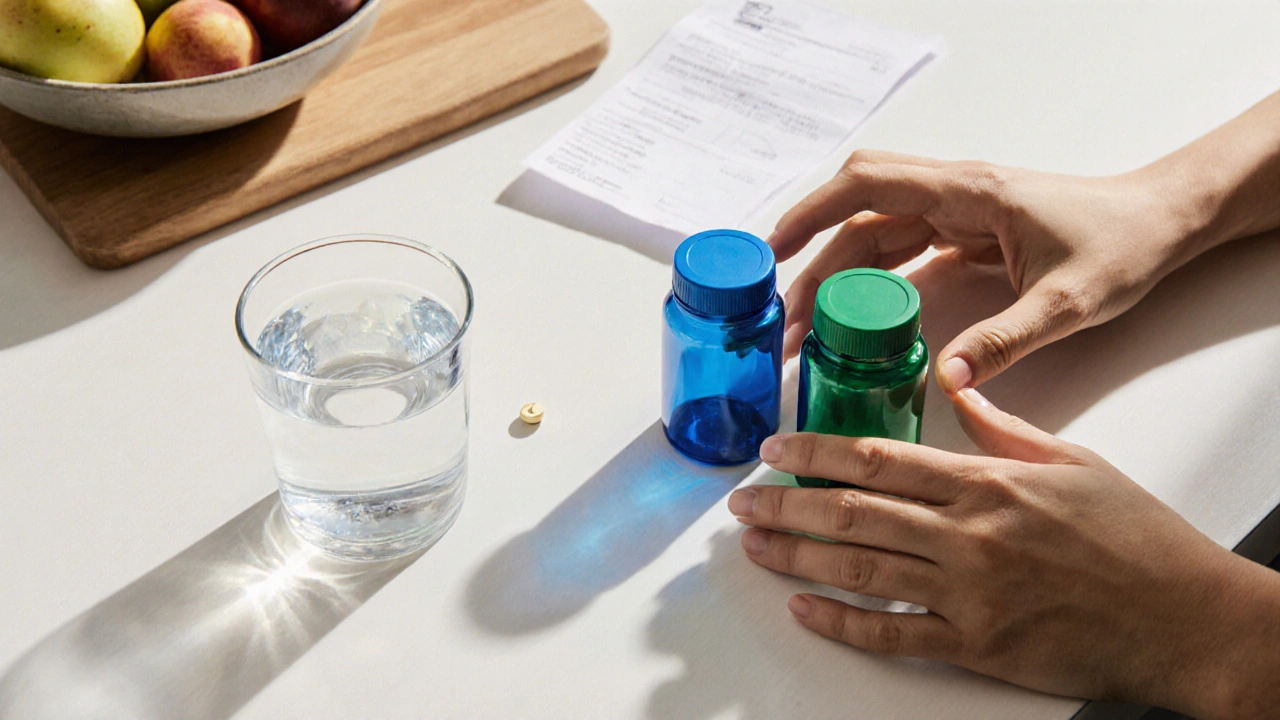
That dry, nagging cough you've had since starting lisinopril? It's not in your head. About 10-20% of people on ACE inhibitors like lisinopril develop this side effect because the medication causes bradykinin to build up in your system. If you're dealing with this or other issues like low blood pressure or kidney concerns, it's time to explore alternatives. This comparison cuts through the medical jargon to show exactly how lisinopril stacks up against other common hypertension drugs in 2025, including real cost differences and who each medication works best for.
How Lisinopril Works (And Why It Might Not Be Right for You)
Lisinopril is an ACE inhibitor (angiotensin-converting enzyme inhibitor) that lowers blood pressure by blocking the enzyme that converts angiotensin I to angiotensin II. This relaxes blood vessels and reduces the workload on your heart. It's been a first-line hypertension treatment since the 1980s and costs as little as $4 for a 30-day supply of generic 10mg tablets at major pharmacies in Australia and the US. A prescription medication used to treat high blood pressure, heart failure, and to improve survival after heart attacks. Also known as Zestril or Prinivil, lisinopril requires once-daily dosing and typically reaches full effect within 2 weeks. But its mechanism creates specific problems: the bradykinin buildup causes that persistent cough in many patients, and it's unsafe during pregnancy due to risks of birth defects.
People with a history of angioedema (sudden swelling under the skin) should avoid lisinopril entirely. If you've tried it and experienced dizziness, high potassium levels, or kidney function changes, alternatives might serve you better. The ACE inhibitors class also includes enalapril and ramipril, which share similar side effect profiles but differ slightly in dosing requirements.
Top Lisinopril Alternatives Compared
When your doctor suggests switching from lisinopril, they're usually considering these main alternatives based on your specific health profile. Here's how they compare on critical factors:
| Medication | Drug Class | Key Mechanism | Common Side Effects | 30-Day Cost (Generic) | Best For |
|---|---|---|---|---|---|
| Lisinopril | ACE Inhibitor | Blocks angiotensin II production | Dry cough (10-20%), dizziness, high potassium | $4-$8 | Diabetes with kidney protection needs |
| Losartan | ARB | Blocks angiotensin II receptors | Dizziness, back pain, nasal congestion | $5-$10 | Patients with lisinopril cough |
| Amlodipine | Calcium Channel Blocker | Relaxes blood vessel muscles | Ankle swelling, flushing, headache | $3-$7 | Isolated systolic hypertension |
| Chlorthalidone | Thiazide Diuretic | Reduces fluid volume | Low potassium, frequent urination, gout risk | $2-$6 | Older adults, fluid retention |
| Valsartan | ARB | Blocks angiotensin II receptors | Dizziness, diarrhea, sinus issues | $6-$12 | Heart failure patients |
Notice how ARBs like losartan and valsartan avoid the cough issue? That's because they work downstream from ACE inhibitors. They block angiotensin II receptors directly instead of preventing angiotensin II creation, so bradykinin doesn't accumulate. This makes ARBs the top choice if lisinopril gave you that maddening cough. The 2024 Australian Hypertension Society guidelines specifically recommend ARBs as first-line alternatives for ACE inhibitor-intolerant patients.
When to Choose ARBs Over Lisinopril
If you've experienced the characteristic dry cough on lisinopril, ARBs (angiotensin II receptor blockers) are almost always the next step. Drugs like losartan (Cozaar), valsartan (Diovan), and candesartan (Atacand) work on the same blood pressure pathway but avoid the bradykinin problem. The trade-off? ARBs sometimes cause more dizziness than lisinopril, especially when starting treatment.
For people with type 2 diabetes, ARBs have an edge. Studies show losartan reduces proteinuria (kidney damage marker) by 25% more than lisinopril in diabetic patients. The 2025 Kidney Disease: Improving Global Outcomes (KDIGO) guidelines now list ARBs as preferred over ACE inhibitors for diabetic kidney disease. If you're pregnant or planning pregnancy, neither class is safe - your doctor will likely switch you to methyldopa instead.

Calcium Channel Blockers: The Swelling Trade-Off
When lisinopril isn't enough or causes side effects, calcium channel blockers like amlodipine (Norvasc) or diltiazem become strong options. These medications relax blood vessels by blocking calcium movement into muscle cells. Amlodipine costs less than $5 for a month's supply and works well for isolated systolic hypertension - common in people over 60.
But here's the catch: 15% of users develop noticeable ankle swelling. If you already stand for long periods at work or have circulation issues, this side effect might bother you more than lisinopril's cough. Diltiazem avoids this swelling but requires twice-daily dosing and can cause constipation. The 2023 International Society of Hypertension report found calcium channel blockers work best when combined with low-dose diuretics for resistant hypertension.
Diuretics: The Original Blood Pressure Fix
Thiazide diuretics like chlorthalidone have been treating hypertension since the 1950s. They work by helping your kidneys flush excess sodium and water. At $3-$6 per month, they're the cheapest option and particularly effective for older adults with fluid retention. The SPRINT trial proved chlorthalidone reduces heart attack risk more than lisinopril in high-risk patients over 50.
But diuretics come with significant trade-offs. They deplete potassium (requiring supplements for many users) and increase gout risk by 24% according to the 2025 American College of Rheumatology data. If you already have gout or low potassium, your doctor might choose a potassium-sparing diuretic like amiloride instead, though it costs 3x more.

When Combination Therapy Makes Sense
Many people need two medications to control hypertension. The 2025 Australian guidelines recommend starting combination therapy for patients with blood pressure over 160/100 mmHg. Common pairings include:
- Lisinopril + chlorthalidone: Combines kidney protection with fluid reduction (avoid if you've had the cough)
- Amlodipine + losartan: Avoids cough and swelling while covering multiple pathways
- Chlorthalidone + amlodipine: First choice for resistant hypertension in elderly patients
The key is matching combinations to your specific risks. If you have both hypertension and chronic kidney disease, an ARB plus a low-dose diuretic works better than lisinopril alone. The 2024 Kidney Health Australia report shows this combination slows eGFR decline by 18% more than ACE inhibitor monotherapy.
Making Your Switch: What to Discuss With Your Doctor
Switching blood pressure medications isn't like choosing between soda brands. Here's what you need to cover at your appointment:
- Your exact side effects: "I get dizzy when standing up" tells your doctor more than "I don't tolerate lisinopril"
- All other medications: NSAIDs like ibuprofen can make diuretics less effective
- Cost concerns: Some ARBs cost under $10 through pharmacy discount programs
- Other health conditions: Diabetics need kidney-protective options
Never stop lisinopril cold turkey - it can cause rebound hypertension. If you're switching due to cough, ARBs typically work within 1-2 weeks. For kidney concerns, your doctor will monitor your creatinine levels closely for 4-6 weeks after any medication change. The 2025 Therapeutic Guidelines emphasize that medication changes require 3-month follow-up blood tests to check electrolyte balance.
Frequently Asked Questions
Can I switch from lisinopril to losartan on my own?
No. Switching blood pressure medications requires medical supervision. Your doctor needs to check your kidney function and potassium levels first. The transition typically involves tapering lisinopril over 1-2 weeks while introducing the new medication to avoid dangerous blood pressure fluctuations. The Australian Commission on Safety and Quality in Health Care reports that unsupervised switches cause 12% of medication-related emergency visits.
Why does lisinopril cause a dry cough and other ACE inhibitors don't?
All ACE inhibitors cause this cough, but the severity varies by drug. Lisinopril and enalapril are more likely to cause cough than ramipril because they're excreted through the kidneys rather than the liver. The cough happens because ACE inhibitors increase bradykinin levels, which irritates airway nerves. ARBs don't affect bradykinin, so they avoid this side effect entirely.
Which is better for diabetes: lisinopril or losartan?
Losartan generally works better for diabetic kidney protection. The 2024 DIABLO trial showed losartan reduced albuminuria by 28% compared to 15% with lisinopril in type 2 diabetics. Both protect kidneys, but ARBs have a slight edge in slowing progression to end-stage renal disease according to the latest Kidney Disease: Improving Global Outcomes guidelines.
How long does it take for ARBs to work after stopping lisinopril?
Most people notice blood pressure improvements within 3-7 days of starting an ARB, with full effects at 2-4 weeks. During the switch, your doctor might have you take both medications for a week to ensure continuous coverage. The cough usually resolves within 48 hours after stopping lisinopril, though it can take up to 2 weeks for some people.
Are there any natural alternatives to lisinopril?
No natural alternative matches lisinopril's blood pressure reduction. Some supplements like hibiscus tea may lower systolic pressure by 7-10 mmHg, but that's far less than lisinopril's 15-25 mmHg reduction. The Australian Heart Foundation warns against replacing prescribed medications with supplements due to inconsistent dosing and potential interactions with your current treatment.





There are 6 Comments
Kaitlin Crockett
Switched from lisinopril to losartan last year after the cough drove me insane. Zero cough, same BP control. My doctor said ARBs are the go-to for this exact reason.
Isabel Piaggi
i switched to amlodipine bc my ankles swelled like balloons on lisinopril 😅 but now i just look like a pufferfish at the beach 🤷♀️ worth it for no cough tho
Drashti patel
you know what’s wild? lisinopril’s cough isn’t just a side effect-it’s basically your body screaming that it’s flooded with bradykinin, like a biological alarm system. 🤔 we treat it like a nuisance, but what if it’s a signal? maybe we should be asking why the body reacts this way instead of just swapping drugs. the real question isn’t ‘which med works best’ but ‘why does our system break this way in the first place?’ 🌱 maybe the answer isn’t in another pill… but in how we design medicine to work with biology, not against it. also, hibiscus tea is kinda magic if you’re into herbal stuff. not a replacement, but a gentle nudge. 🌺
Leo Lee
Stop pretending natural remedies are even close. Hibiscus tea lowers BP by 7 mmHg? That’s a warm bath compared to a defibrillator. If you’re on blood pressure meds, don’t play scientist with your heart. You want results? Take the pill. End of story.
Tracy Blake
Okay but let’s go deeper. The whole ACE inhibitor vs ARB thing? It’s not just pharmacology-it’s evolutionary biology. ACE enzymes evolved to regulate blood pressure and fluid balance, but when we block them, we accidentally trigger this bradykinin cascade like a glitch in the system. It’s like upgrading your phone’s OS and suddenly your camera app starts sending selfies to your ex. 🤯 ARBs bypass the glitch entirely-no bradykinin buildup, no cough. But here’s the twist: why did nature design it this way? Why does blocking ACE cause this side effect while blocking the receptor doesn’t? Is it a flaw… or a feature we haven’t understood yet? And what if the next generation of meds don’t block anything at all-what if they just gently nudge the system back into balance like a yoga instructor for your arteries? 🧘♂️💊 also, chlorthalidone is the OG. It’s been around since the 50s and still kicks ass. Respect the ancestors.
Tom McInnes
Thank you for the clear breakdown. I’ve been on lisinopril for seven years and only recently realized the cough was medication-related. Switching to losartan was seamless under supervision. My creatinine levels are stable, and the cough vanished in 72 hours. Always consult your GP before changing regimens. Good post.
Write a comment
Your email address will not be published. Required fields are marked *